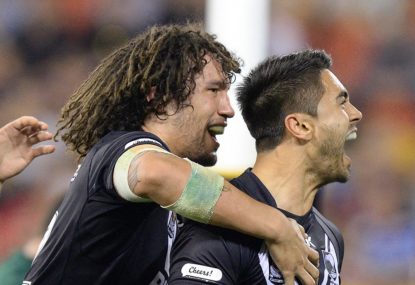Paradox of parity: NRL craves a level playing field but fans love to hate a dynasty like Penrith’s undisputed reign
The paradox of parity is that even though we’re told we should want a wide open competition, the NRL seems to be more interesting…

The reports of my death are greatly exaggerated, Mark Twain once famously said. The same can be said for international rugby league, after the Four Nations kicked off successfully in Brisbane on the weekend.
Nearly 48,000 people turned up to Suncorp Stadium on Saturday to see Samoa take on England and Australia face New Zealand.
It was a tournament that had some question marks hanging over it after a large number of stars were unavailable, everyone from cross-coders Sam Burgess and Sonny Bill Williams, to the suspended Issac Luke, the injured England skipper Sean O’Loughlin and about a hundred Kangaroos players, from Johnathan Thurston to Paul Gallen and potential NFL recruit Jarryd Hayne.
Many weren’t expecting much from this Four Nations. But just two games in they have already been proved wrong.
Both matches were exciting, highly entertaining affairs that proved international rugby league has value. There’s life in the old girl yet.
Samoa threw everything but the kitchen sink against England and were unlucky not to come away with the win. The Poms were rusty but just got over the line in the end by a converted try.
Daryl Clark showed what a class act he is and halves Matty Smith and Gareth Widdop ran the show. Having more players in the NRL is proving to be a boon for England.
Samoa were wild and unpredictable, but led down by their organisation and structure at times, as well as their goal-kicking. Having Anthony Millford in their side could have been the difference.
And then the Kiwis well and truly beat the Kangaroos, romping to an 18-point victory. Apart from Australia’s early try, it was largely one-way traffic from the men in black.
The Aussie forwards, weakened by the loss of several players but also by some strange selections, were bullied by their Kiwi counterparts. Injuries to Greg Inglis and Daly-Cherry-Evans during the game didn’t help matters, but it was much deserved win to New Zealand.
With Luke to come back in, confidence will be high in the Kiwi camp.
For the Kangaroos side Tim Sheens needs to sort out his line-up and quick. Playing Sam Thaiday as a prop doesn’t work.
Both of those contests, thrilling as they were, showed that international footy is worthwhile.
But for those who caught some of the last year’s World Cup, this wouldn’t be a revelation.
The 2013 tournament was the most successful in the code’s history, made a good profit and attracted great crowds. It went to new markets, pulling in punters in Bristol and other areas, generated great atmospheres in France and dished up probably the best match of the year in any rugby league competition with the engaging semi-final between England and New Zealand at Wembley.
While little has been done since the World Cup, that’s not to say to international rugby league is dying or dead.
Two weeks ago Ireland upset France in the European Championships. In a match that wasn’t televised, a rookie Irish team defeated a French side that was filled with Super League regulars.
It is these kind of results, these upsets and unpredictability that has to underpin a international sport.
Rugby league is growing in many areas across the globe and it needs a strong international federation to help it along, but that’s fodder for another piece.
Self-interest and short-sightness has crippled the game’s advance into new territories. But the World Cup and indeed this Four Nations has demonstrated there is an appetite for international footy.
These contests can give rugby league fans, here in Australia and elsewhere, something NRL matches cannot.
So let’s not death-ride the international side of the sport without giving it a fair chance
Follow John Davidson on Twitter @Johnnyddavidson